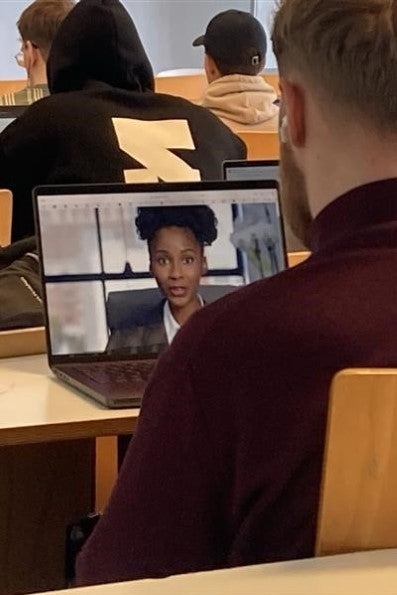In a strategic case exercise, his students received support from avatars acting as digital top executives, guiding them throughout the process. What did this look like in practice? And is this slowly pushing the role of the lecturer into the background? Tjemkes shares his insights.
Learning through talking to programmed experts
In the Foundations of Strategic Management course, Tjemkes introduced his students to avatars programmed as CEOs, CFOs, CMOs or CHROs. Rather than simply reading or listening, students actively engaged in conversations with these avatars. This way, they practised strategic thinking, learned to adapt quickly to new situations, and experienced firsthand what it means to take a management role seriously. “Normally, during a lecture, I would explain what a CEO or CFO does, but now students could experience it themselves by simply engaging in a dialogue. It made the learning experience much more interesting and impactful,” says Tjemkes.
Students worked in teams of four, with each student being assigned a specific role. Using the Heygen platform, integrated into Canvas, they could spar one-on-one with an avatar tailored to their role. “The avatars really helped students step into their roles,” Tjemkes explains. “A CEO thinks differently from a CFO, and you can learn that much faster by actively engaging in conversation.”
While students individually explored their roles with the help of avatars, they also had to collaborate with their fellow students to complete the assignment, engage in discussions, and make joint decisions.
AI-generated newsflash shakes up decision making
Another feature of the course was the use of an AI-generated news broadcast. While working on their case, students suddenly received an update announcing a new crisis at the company they were analysing. “The AI video deliberately disrupted the decision-making process, giving teams a new challenge that forced them to adjust their plans and seek advice again through their consultancy avatars,” says Tjemkes.
“The video really added a new dynamic to the lecture. Students had to rethink their original strategies under time pressure, adapt quickly, and collaborate closely. It made the case more lively and showed just how critical flexibility and teamwork are in strategic decision-making.”
Human interaction remains key
It was also a unique experience for Tjemkes himself: “When students are deeply engaged in conversations with avatars, you wonder: if avatars take over explaining the material, what is left for the lecturer to do? But in the debriefing - when you reflect, connect, and explore ideas - the lecturer steps back into focus. Human interaction remains invaluable. AI can support learning, but it cannot replace the human touch needed for deeper understanding and ethical discussions.”
Students also responded enthusiastically, especially appreciating the direct interaction with their role-specific avatars. “At the same time, we noticed that students still need guidance in asking the right questions. Knowing how to prompt AI effectively really is a skill on its own,” Tjemkes says.
As a lecturer, how do you facilitate such a session?
This pilot was made possible with support from the VU Centre for Teaching & Learning (VU CTL), the VU Education Lab, and SBE colleagues who assisted with the technical setup and avatar programming.
According to Tjemkes, the concept has potential far beyond these strategy courses: “The setup - using avatars, a realistic case, and a clear learning objective - could become a VU-wide tool. With the right support, many more courses could integrate AI avatars into their teaching.”
Looking back, Tjemkes calls the experiment a great success. “It fits really well within our Active Blended Learning approach. We combined digital tools with physical collaboration, which led to real learning depth. Of course, there are still challenges, like improving Wi-Fi capacity and refining the assignments. All in all, it proved there’s plenty worth exploring further.”


